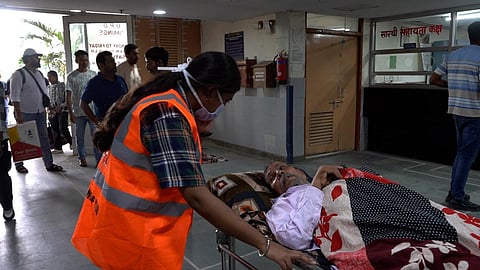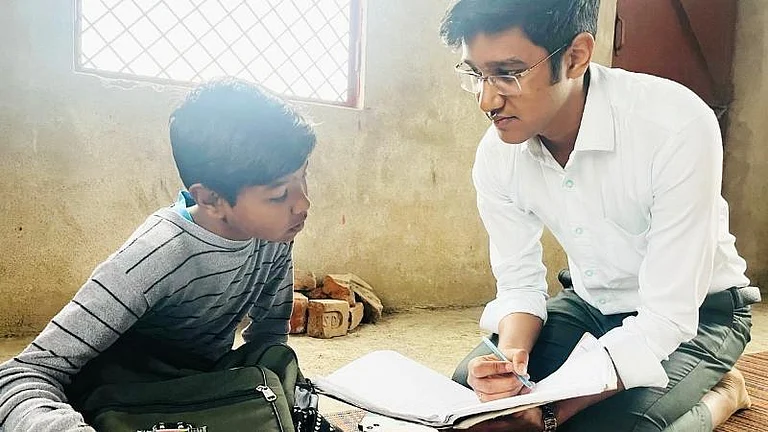Within 17 months, SARATHI expanded to 30 states and UTs with over 7,200 trained student volunteers, supported by the Health Ministry for rollout in 1,467 hospitals across India.
The initiative, integrated with the NSS, has reduced patient waiting time by one-third, improved lab utilisation and queue management, and significantly enhanced patient satisfaction.
Following its success, the Union Health Ministry has approved expansion of SARATHI to all AIIMS, marking it as a pioneering people-driven model of youth-led healthcare assistance.
Transformative Initiative
Inspired by a volunteer model observed at Henry Ford Health Hospital in the US, IAS officer Pankaj Rai launched the SARATHI initiative at PGIMER, Chandigarh, to assist patients and improve hospital efficiency.
Pankaj Rai, a Himachal Cadre IAS officer, never knew that his trip to Henry Ford Health Hospital, Detroit, in the USA, would turn into a landmark transformative initiative at the Post-Graduate Institute of Medical Education and Research (PGIMER) Chandigarh, where he serves as Deputy Director (Administration).
In October 2019, while attending an advanced training program at the University of Chicago Booth School of Business, he visited the Henry Ford Health Hospital. There, he observed two children of Dr. Monica Aggarwal, an Indian doctor at the hospital, engaged in voluntary service—helping patients and their attendants with remarkable dedication.
After returning and joining PGIMER, Chandigarh, Rai reconnected with Dr. Monica Aggarwal to seek detailed insights into how the volunteer initiative at her hospital helped reduce patients’ waiting times. He aimed to replicate a similar model at PGIMER, where over 30 lakh patients visit the OPDs each year, often leading to overcrowded and chaotic conditions.

Within 17 months of the rollout of the scheme titled SARATHI (Students Alliance for Responsible Action to Transform Healthcare Institutes), PGIMER has scripted a story that has now been scaled across 30 states and Union Territories (UTs) with over 7,200 trained volunteers—mostly students of local colleges and professional teaching institutes. The Ministry of Health has approved introducing the initiatives in 1,467 hospitals in India, significantly expanding its demographic reach
“This is the first of its kind people-driven solution to bridge the gap between patients and the healthcare system. Sarathis are NSS volunteers drawn from diverse educational institutions to assist patients/attendants at OPDs. They are mandated to facilitate registrations, lab processes, hospital navigations, help manage queues, bill payments, and find the right doctor specific to the needs of a patient,” explains Rai.
The student volunteers (sarathis) primarily focus on assisting first-time OPD visitors, senior citizens, differently abled individuals, and critically ill patients to help minimise their waiting time. Each volunteer is expected to contribute 60 hours of service—four hours daily over 15 days. The initiative has also been integrated with the National Service Scheme (NSS) to ensure wider participation and structured engagement.
The Ministry of Youth Affairs and Sports has already issued a letter on December 24, 2024, to all Regional Directors of the NSS in this regard.
“Initially launched with students, but now the scheme is open to other volunteers, who are provided with a distinctive uniform for easy identification.” says Jaswinder Singh, a paramedical staffer.
As per a survey done by an independent agency, commissioned by the PGIMER, the project Sarathi has helped to bring a paradigm shift in the improvement of patient care, reducing the wait time by one-third (from 4.2 hours to 2.8 hours), higher lab utilisation by 1.09-fold, improving queue management, and increasing patient satisfaction by 1.11-fold.
Just a month back, Vivek Malhotra—a doctor from Patiala—brought his mother to the OPD following renal failure. Deeply touched by the care and assistance extended by the student volunteers, he personally reached out to Dr. Vivek Lal, Director of PGIMER, to express his appreciation for the commendable efforts of the Sarathis at the OPD.
Director of PGIMER Vivek Lal outlines two basic goals of the project: to make hospital navigation easier for patients and to channelise the energy of youth for meaningful community service within the healthcare system. The project has successfully achieved both goals.
At the Governing Body meeting of PGIMER, held on September 2, 2025, under the chairmanship of Union Health Minister J. P. Nadda, it was decided to expand the project to all AIIMS across the country. “NSS volunteers have now also been designated as My Bharat Volunteers,” Rai informed.

Tanish Mourya, a student volunteer from Government PG College, Sector 11, shared his experience, saying, “My journey as a volunteer has been truly life-changing. This experience has taught me the true meaning of service. The real rewards are not medals or trophies, but the heartfelt blessings of those we cared for at the OPDs.”
What began as a modest pilot project with just 22 volunteers from the Government Polytechnic College for Women, Chandigarh, for a 7-day trial, has since evolved into a powerful model of community engagement in patient-centric healthcare.
The PGIMER is now planning to expand the project to the Advanced Eye Centre (AEC), Advanced Cardiac Centre (ACC), and Advanced Paediatric Centre (APC) and may also include the emergencies, maybe a bit later.
Tags


